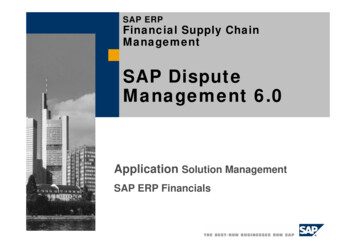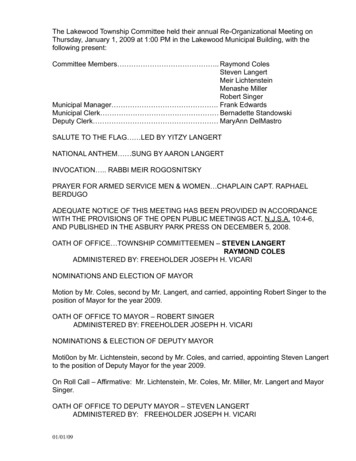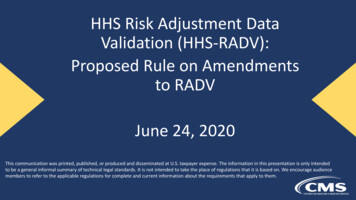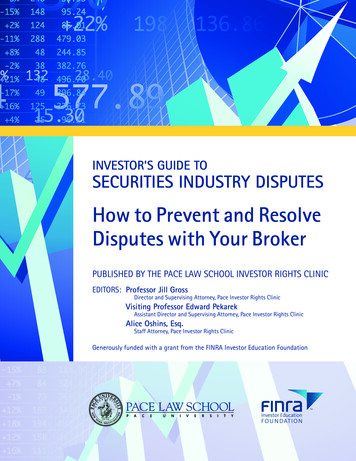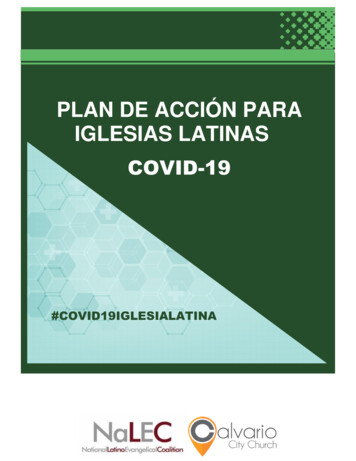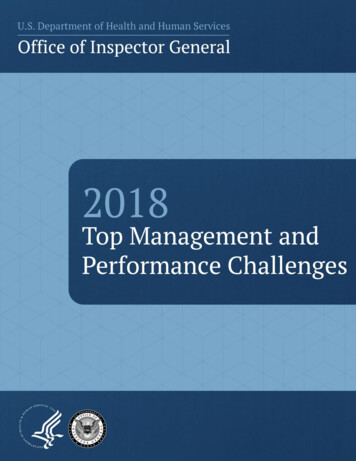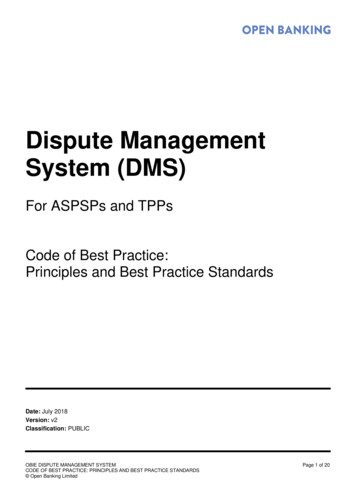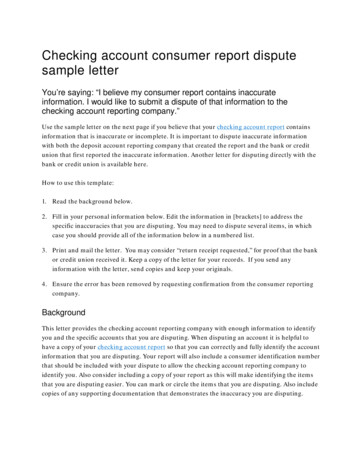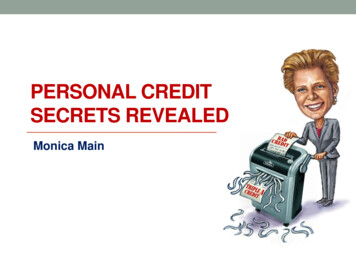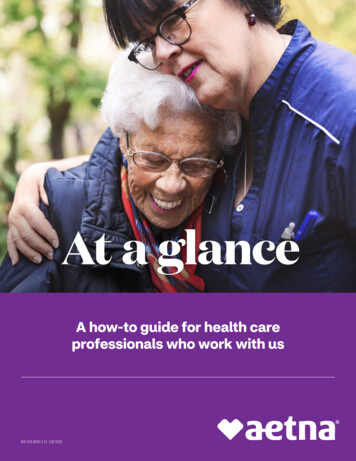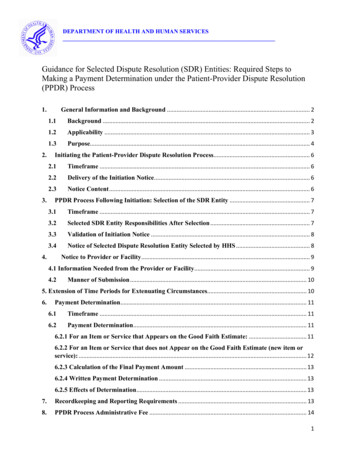
Transcription
DEPARTMENT OF HEALTH AND HUMAN SERVICESGuidance for Selected Dispute Resolution (SDR) Entities: Required Steps toMaking a Payment Determination under the Patient-Provider Dispute Resolution(PPDR) Process1.2.3.General Information and Background . 21.1Background . 21.2Applicability . 31.3Purpose. 4Initiating the Patient-Provider Dispute Resolution Process. 62.1Timeframe . 62.2Delivery of the Initiation Notice . 62.3Notice Content . 6PPDR Process Following Initiation: Selection of the SDR Entity . 73.1Timeframe . 73.2Selected SDR Entity Responsibilities After Selection . 73.3Validation of Initiation Notice . 83.4Notice of Selected Dispute Resolution Entity Selected by HHS . 84.Notice to Provider or Facility . 94.1 Information Needed from the Provider or Facility. 94.2Manner of Submission . 105. Extension of Time Periods for Extenuating Circumstances. 106.Payment Determination. 116.1Timeframe . 116.2Payment Determination. 116.2.1 For an Item or Service that Appears on the Good Faith Estimate: . 116.2.2 For an Item or Service that does not Appear on the Good Faith Estimate (new item orservice): . 126.2.3 Calculation of the Final Payment Amount . 136.2.4 Written Payment Determination . 136.2.5 Effects of Determination. 137.Recordkeeping and Reporting Requirements . 138.PPDR Process Administrative Fee . 141
8.1Administrative Fee . 148.2 Failure to Pay the Administrative Fee . 159.Confidentiality Requirements . 159.1 Privacy . 159.2 Security . 159.3 Breach and Incident Notification. 169.4 Timing, Form, and Manner of Breach Notification . 17Appendix A – Definitions . 19Appendix B – State-Federal Interaction . 22Appendix C – Summary of the Patient-Provider Dispute Resolution (PPDR) Process. 23Appendix D – Other Resources. 251.General Information and Background1.1BackgroundEffective January 1, 2022, the No Surprises Act 1 (NSA) protects uninsured (or self-pay)individuals from many unexpectedly high medical bills. Providers and facilities will be requiredto furnish a good faith estimate of expected charges after an item or service is scheduled, or uponrequest. Throughout this document the term “providers” also includes providers of air ambulanceservices. The good faith estimate will include an enumerated list of items and services, groupedby each provider or facility, reasonably expected to be provided for the primary item or service,and items and services reasonably expected to be furnished in conjunction with the primary itemor service, for that period of care. Additionally, a new patient-provider dispute resolution(PPDR) process will be available for uninsured (or self-pay) individuals who get a bill for anitem or service that is substantially in excess of the expected charges on the good faith estimate.Under the PPDR process, an uninsured (or self-pay) individual, or their authorizedrepresentative 2, may initiate the PPDR process for a determination about how much to pay aprovider or facility for specific items or services. This process can provide important consumerprotections for the uninsured (or self-pay) individual from billed charges that are substantially inexcess of the expected charges in the good faith estimate.An uninsured (or self-pay) individual is an individual who does not have health insurancebenefits for an item or service under a group health plan, group or individual health insurancecoverage offered by a health insurance issuer, federal health care program (as defined in section1128B(f) of the Social Security Act), or a health benefits plan under chapter 89 of title 5, UnitedStates Code; or an individual who has benefits for an item or service under a group health planor individual orEnacted as part of the Consolidated Appropriations Act, 2021 (Pub. L. 116-260).Authorized representative means an individual authorized under State law to provide consent on behalf of the uninsured (orself-pay) individual, provided that the individual is not a provider affiliated with a facility or an employee of a provider or facilityrepresented122
group health insurance coverage offered by a health insurance issuer, or a health benefits planunder chapter 89 of title 5, United States Code, but does not seek to have a claim for such item orservice submitted to such plan or coverage.On October 7, 2021, HHS published in the Federal Register interim final rules (IFRs) titledRequirements Related to Surprise Billing; Part II, 3 implementing various provisions of the NSA,including good faith estimates and the PPDR process for payment determinations.1.2ApplicabilityThe requirements for health care providers and health care facilities related to the issuance ofgood faith estimates of expected charges for uninsured (or self-pay) individuals (or theirauthorized representatives), upon request or upon scheduling an item or service under 45 CFR149.610 are generally applicable for good faith estimates requested on or after January 1, 2022 orfor good faith estimates required to be provided in connection with items or services scheduledon or after January 1, 2022.HHS recognizes that some providers or facilities may need to establish efficient and securecommunication channels for transmission of good faith estimate information between conveningproviders or facilities and co-providers and co-facilities. A convening health care provider orconvening health care facility is the provider or facility who receives the initial request for agood faith estimate from an uninsured (or self-pay) individual and who is or, in the case of arequest, would be responsible for scheduling the primary item or service. A co-provider or cofacility is a provider or facility that furnishes items or services that are customarily provided inconjunction with a primary item or service. It is also understood that it may take time forproviders and facilities to develop systems and processes for receiving and providing therequired information from co-providers and co-facilities. Therefore, for good faith estimatesprovided to uninsured (or self-pay) individuals from January 1, 2022 through December 31,2022, HHS will exercise its enforcement discretion in situations where a good faith estimateprovided to an uninsured (or self-pay) individual does not include expected charges from coproviders or co-facilities. A co-provider or co-facility is not prohibited from furnishing theinformation before December 31, 2022, and nothing would prevent the uninsured (or self-pay)individual from separately requesting a good faith estimate directly from the co-provider or cofacility, in which case the co-provider and co-facility would be required to provide the good faithestimate for such items or services. Otherwise during this period, HHS encourages conveningproviders and convening facilities to include a range of expected charges for items or servicesreasonably expected to be provided and billed by co-providers and co-facilities. To the extentstates are the primary enforcer of these requirements, HHS encourages states to take a similarapproach, and will not consider a state to be failing to substantially enforce these requirements ifit takes such an approach from January 1, 2022 through December 31, 2022.The IFR establish a PPDR process that is applicable to uninsured (or self-pay) individuals;providers, facilities, and providers of air ambulance services; and Selected Dispute Resolution(SDR) entities, beginning on or after January 1, 2022. More specifically, the PPDR process -billing-part-ii.3
be used for payment determination if the total billed charges (by the convening provider,convening facility, or co-provider or co-facility listed in the good faith estimate), aresubstantially in excess of the total expected charges for that specific provider or facility listed onthe good faith estimate, as required under 45 CFR 149.610.The provisions regarding SDR entity certification under 45 CFR 149.620(a) and (d), areapplicable beginning on October 7, 2021.1.3PurposeThe purpose of this document is to provide guidance to SDR entities on various aspects of thePPDR process. This document includes information about how uninsured (or self-pay)individuals may initiate the PPDR process and the general requirements of the PPDR Process. Italso provides information about the selection process and criteria for SDR entities, therequirements SDR entities must follow when making payment determinations, guidance onconfidentiality standards, record keeping requirements, the revocation of certification, as well ashow parties should request an extension of time periods for extenuating circumstances. For adetailed overview of the PPDR process, see the visual below, “Patient-Provider DisputeResolution Process Overview.” Additional guidance may be developed in the future to addressspecific questions or scenarios submitted by SDR entities.4
5
2.Initiating the Patient-Provider Dispute Resolution Process2.1TimeframeAn uninsured (or self-pay) individual (or their authorized representative) may initiate the PPDRprocess by submitting an Initiation Notice via the Federal IDR portal, electronic or postal mailto HHS within 120 calendar days of receiving the initial bill containing charges for the item orservice that is substantially in excess of the expected charges in the good faith estimate.The initiation date of the PPDR process is the date that HHS receives the Initiation Notice. Theonline Federal IDR portal will display the date on which the Initiation Notice has been receivedby HHS.In addition, the uninsured (or self-pay) individual must submit an administrative fee to the SDRentity in an amount and manner specified by HHS in PPDR fee guidance.2.2Delivery of the Initiation NoticeThe Initiation Notice sent by the uninsured (or self-pay) individual (or their authorizedrepresentative) must be submitted to HHS: 2.3through the online Federal IDR portal,electronically (such as email), oron paper through the mail.Notice ContentThe Initiation Notice must include: Information sufficient to identify the item or service under dispute, including:o The date the item or service was provided; ando A description of the item or service.A copy of the provider or facility bill for the item and service under dispute (the copy canbe a photocopy or an electronic image so long as the document is readable);A copy of the good faith estimate for the item or service under dispute (the copy can be aphotocopy or an electronic image so long as the document is readable);If not included on the good faith estimate, contact information of the provider or facilityinvolved, including, if available:o Name;o Email address;o Phone number; ando Mailing address.The State where the items or services in dispute were furnished; andThe uninsured (or self-pay) individual’s contact information and communicationpreference:o Name;6
ooooPhone number;Mailing Address;Email;Communication preference: Electronic mail (e-mail), paper mail, or phone.3.PPDR Process Following Initiation: Selection of the SDREntity3.1Timeframe3.2Selected SDR Entity Responsibilities After SelectionUpon receiving the Initiation Notice for the PPDR process from an uninsured (or self-pay)individual, HHS will select one of the contracted SDR entities to conduct the PPDR process.After the SDR entity is selected by HHS, the SDR entity may attest that a conflict of interestexists, as described below in section 3.2.1. If no conflicts of interest exist, the SDR entity mustnotify the uninsured (or self-pay) individual and the provider or facility of the selection of theSDR entity through the Notice of SDR Entity Selected by HHS, described in section 3.4 of thisguidance.If either party to the PPDR process, the uninsured (or self-pay) individual, or the provider orfacility, attest that a conflict of interest exists in relation to the SDR entity assigned to a paymentdispute, the SDR entity must notify HHS within three business days after receiving theattestation. Should a conflict of interest exist, HHS will then select a new SDR entity to conductthe PPDR process for the item or service. In the event that no SDR entities are available toresolve the dispute, the initially-selected SDR entity will be required to initiate their entity-levelconflict of interest mitigation plan, which may include identifying a sub-contractor whom theyhave verified does not have conflicts of interest. HHS will then assign the case to the identifiedsub-contractor to conduct the PPDR process for the item or service in dispute.3.2.1Conflicts of InterestAn SDR entity must not have any conflicts of interest with respect to a party to a paymentdetermination. Specifically, the SDR entity cannot have with respect to a party to the paymentdetermination a material relationship, status, or condition of the party that impacts the ability ofthe SDR entity to make an unbiased and impartial payment determination. In accordance with 45CFR 149.620(e)(3), a conflict of interest exists when an SDR entity is: A provider or a facility;An affiliate or a subsidiary of a provider or facility;An affiliate or subsidiary of a professional or trade association representing a provider orfacility; orAn SDR entity, or any personnel assigned to a determination has a material familial,financial, or professional relationship with a party to the payment determination being7
disputed, or with any officer, director, or management employee of the provider, theprovider's group or practice association, or the facility that is a party to the dispute.3.3Validation of Initiation NoticeAfter selection by HHS, the SDR entity will review the Initiation Notice to ensure the items orservices in dispute meet the eligibility criteria described in 45 CFR 149.620(b) and that theInitiation Notice contains the required information described in Section 2 of this guidance. If theSDR entity determines that the item or service meets the eligibility criteria, and the InitiationNotice contains the required information, the SDR entity will notify the uninsured (or self-pay)individual and the provider or facility that the item or service has been determined eligible fordispute resolution by sending the Notice of SDR Entity Selected by HHS as described insection 3.4 of this guidance.If the SDR entity determines that the item or service does not meet the eligibility criteria or thatthe Initiation Notice is incomplete, the SDR entity will provide an Insufficient Notice to theuninsured (or self-pay) individual of the determination and the reasons for the determination andwill notify the uninsured (or self-pay) individual that they may submit supplemental information,postmarked within 21 calendar days, to resolve any deficiencies identified. If the InsufficientNotice is not made available to an individual in a format that is accessible to individuals withdisabilities or with low-English proficiency within 14 calendar days of such a request from theindividual, a 14-calendar-day extension will be granted so that the individual will have a total of35 calendar days to submit supplemental information.3.4Notice of Selected Dispute Resolution Entity Selected by HHSOnce HHS selects an SDR entity, the SDR entity will, through the Federal IDR portal, orelectronic or paper mail, or phone, send the Notice of SDR Entity Selected by HHS to theuninsured (or self-pay) individual, and to the provider or facility to notify that a PPDR initiationnotice has been received and is under review. Such notice shall also include: Contact information for the SDR entity including:o The SDR entity’s name assigned to the case;o Mailing address;o Phone number; ando Fax number.PPDR case reference number;Sufficient information to identify the item or service under dispute;The date the initiation notice was received;Notice of the additional requirements for providers or facilities while the PPDR processis pending including:o Prohibition on moving the bill for the disputed item or service into collection orthreatening to do so;o Ceasing collection efforts if the bill has already moved into collection;o Requirements to suspend the accrual of any late fees on unpaid bill amounts untilafter the PPDR process has concluded; and8
4.o Prohibition on taking or threatening to take any retributive action against anuninsured (or self-pay) individual for utilizing the PPDR process to seekresolution for a disputed item or service.Information to the uninsured (or self-pay) individual about the availability of consumerassistance resources that can assist the individual with the dispute such as authorizedrepresentatives from state Consumer Assistance Programs (CAPs) or legal aidorganizations;Request for the provider or facility to submit to the SDR entity, through the onlineFederal IDR portal:o A copy of the good faith estimate provided to the uninsured (or self-pay)individual for the item or service under dispute (the copy can be a photocopy oran electronic image so long as the document is readable);o A copy of the billed charges provided to the uninsured (or self-pay) individual forthe item or service under dispute (the copy can be a photocopy or an electronicimage so long as the document is readable); ando If available, documentation demonstrating that the difference between the billedcharge and the expected charges in the good faith estimate reflects the cost of amedically necessary item or service and is based on unforeseen circumstances thatcould not have reasonably been anticipated by the provider or facility when thegood faith estimate was provided.And, the SDR entity’s confirmation that they have no conflicts of interest for the case,meaning they:o Do not have a financial interest in this case and are not an employee of the healthcare provider, facility, or patient;o Did not have a familial, financial, or professional relationship with the health careprovider, facility, or patient within the last year; noro Do not have another conflict of interest with the health care provider, facility, orpatient.Notice to Provider or Facility4.1 Information Needed from the Provider or FacilityNo later than 10 business days after the receipt of the Notice of SDR Entity Selected by HHSthe provider or facility must submit to the SDR entity: A copy of the good faith estimate provided to the uninsured (or self-pay) individual forthe item or service under dispute (the copy can be a photocopy or an electronic image solong as the document is readable);A copy of the billed charges provided to the uninsured (or self-pay) individual for theitem or service under dispute (the copy can be a photocopy or an electronic image so longas the document is readable); andIf available, documentation demonstrating that the difference between the billed chargeand the expected charges in the good faith estimate reflects the cost of a medicallynecessary item or service and is based on unforeseen circumstances that could not have9
reasonably been anticipated by the provider or facility when the good faith estimate wasprovided.Manner of Submission4.2HHS strongly recommends that the information requested in Section 4.1 be submitted throughthe online Federal IDR portal to help ensure timely and secure processing. This information mayalso be submitted through alternative means, such as paper or electronic mail.5. Extension of Time Periods for Extenuating CircumstancesMany of the time periods for the PPDR process may be extended in the case of extenuatingcircumstances at HHS’s discretion. Time periods for payments can NOT be extended: The timing of all payments,including payment of the administrative fee to SDR entities cannot be extended. All othertime periods are eligible for an extension at the HHS’s discretion. What qualifies as “extenuating circumstances” for an extension: HHS may extendtime periods on a case-by-case basis if the extension is necessary to address delays due tomatters beyond the control of the parties or for good cause. Such extension may benecessary if, for example, a natural disaster impedes efforts by providers, or facilities tocomply with time period requirements. Required Attestation of Prompt Action: For the extension to be granted, the partiesmust attest that prompt action will be taken to ensure that the dispute determinations aremade as soon as administratively practicable. How to request an extension: Parties may request an extension, and provide applicableattestations, by submitting a Request for Extension due to Extenuating Circumstancesthrough the online Federal IDR portal, or electronic or paper mail, (if the extension isnecessary to address delays due to matters beyond the control of the parties or for goodcause) including an explanation about the extenuating circumstances that require anextension and why the extension is needed. When to request an extension: A request for an extension can be filed at any time,either before or after a deadline, and HHS will consider the request and may grant theextension. However, requesting an extension does not stop the PPDR process and all ofits timelines unless and until the extension is granted, so parties should continue to meetdeadlines to the extent possible.10
6.Payment Determination6.1Timeframe6.2Payment DeterminationNo later than 30 business days after receipt of the information requested in the Notice of SDREntity Selected by HHS, the SDR entity must make a determination regarding the amount to bepaid by the uninsured (or self-pay) individual, taking into account the requirements in section6.2.When making a payment determination the SDR entity must: Review any documentation submitted by the uninsured (or self-pay) individual, and theprovider or the facility;Make a separate determination for each unique item or service charged as to whether theprovider or facility has provided credible information to demonstrate that the differencebetween the billed charge and the expected charge for the item or service in the goodfaith estimate reflects the costs of a medically necessary item or service; andMake a determination of whether the difference between the billed charge and theexpected charge for the item or service in the good faith estimate is based on unforeseencircumstances that could not have reasonably been anticipated by the provider or facilitywhen the good faith estimate was provided.6.2.1 For an Item or Service that Appears on the Good Faith Estimate: If the billed charge is equal to or less than the expected charge for the item or service ingood faith estimate, the SDR entity must determine the amount to be paid for the item orservice as the billed charge. If the billed charge for the item or service is greater than the expected charge in the goodfaith estimate, and the SDR entity determines that information submitted by the provideror facility does not provide credible information that the difference between the billedcharge and the expected charge for the item or service in the good faith estimate reflectsthe costs of a medically necessary item or service and is based on unforeseencircumstances that could not have reasonably been anticipated by the provider or facilitywhen the good faith estimate was provided, the SDR entity must determine the amount tobe paid for the item or service to be equal to the expected charge for the item or service inthe good faith estimate. If the billed charge for the item or service is greater than the expected charge in the goodfaith estimate, and the SDR entity determines that information submitted by the provideror facility provides credible information that the difference between the billed charge andthe expected charge for the item or service in the good faith estimate reflects the costs ofa medically necessary item or service and is based on unforeseen circumstances thatcould not have reasonably been anticipated by the provider or facility when the good faith11
estimate was provided, the SDR entity must determine as the amount to be paid for theitem or service, the lesser of:o The billed charge; oro The median payment amount paid by a plan or issuer for the same or similarservice, by a same or similar provider in the geographic area, generally meaningone region for each metropolitan statistical area, as described by the U.S. Officeof Management and Budget and published by the U.S. Census Bureau, in a State,and one region consisting of all other portions of the State, and for air ambulanceservices generally meaning - one region consisting of all metropolitan statisticalareas, as described by the U.S. Office of Management and Budget and publishedby the U.S. Census Bureau, in the State, and one region consisting of all otherportions of the State, determined based on the point of pick-up (as defined in 42CFR 414.605), where the services were provided, that is reflected in anindependent database. An independent database is defined as a State’s all-payerclaims database or any third-party database using the methodology described in45 CFR 149.140(c)(3), except that in cases where the amount determined by anindependent database is determined to be less than the expected charge for theitem or service listed on the good faith estimate, the amount to be paid will be theexpected charge for the item or service listed on the good faith estimate. Whencomparing the billed charge with the amount contained in an independentdatabase, the SDR entity should account for any discounts offered by the provideror facility.6.2.2 For an Item or Service that does not Appear on the Good Faith Estimate (new item orservice): If the SDR entity determines that the information submitted by the provider or facilitydoes not provide credible information that the billed charge for the new item or servicereflects the costs of a medically necessary item or service and is based on unforeseencircumstances that could not have reasonably been anticipated by the provider or facilitywhen the good faith estimate was provided, then the SDR entity must determine thatamount to be paid for the new item or service to be equal to 0. If the SDR entity determines that the information submitted by the provider or facilityprovides credible information that the billed charge for the new item or service reflectsthe costs of a medically nec
group health insurance coverage offered by a health insurance issuer, or a health benefits plan under chapter 89 of title 5, United States Code, but does not seek to have a claim for such item or service submitted to such plan or coverage. On October 7, 2021, HHS published
